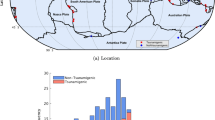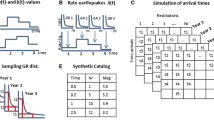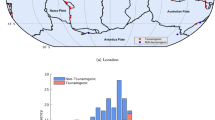Abstract
We present detailed state of the art of statistical kinematic source models. The literature constitutes detailed first- and second-order characterization and the corresponding implementation in random field generations. The notable details include scaling relations, non-Gaussianity, and non-stationarity. The simplicity in the representation of kinematic slip fields has also paved the way to easy numerical implementation. Further, computational facility advancements have aided in realistic real-time simulation. Hence, these models can be suitably utilized to obtain more reliable synthetic ground motions and resultant hazards. This work also demonstrates the implementation of a non-Gaussian slip field in physics-based simulation for the Indo-Gangetic basin and studies the corresponding basin amplification.













Similar content being viewed by others
References
Mai, P.M., Schorlemmer, D., Page, M., Ampuero, J.-P., Asano, K., Causse, M., Custodio, S., Fan, W., Festa, G., Galis, M., et al.: The earthquake-source inversion validation (siv) project. Seismol. Res. Lett. 87(3), 690–708 (2016)
Wang, Y.: Seismic Inversion: Theory and Applications. Wiley, USA (2016)
Andrews, D.: Rupture propagation with finite stress in antiplane strain. J. Geophys. Res. 81(20), 3575–3582 (1976)
Oglesby, D.D., Mai, P.M.: Fault geometry, rupture dynamics and ground motion from potential earthquakes on the north anatolian fault under the sea of marmara. Geophys. J. Int. 188(3), 1071–1087 (2012)
Aki, K., Richards, P.G.: Quantative Seismology: Theory and Methods. W. H. Freeman & Co., New York (1980)
Komatitsch, D., Tromp, J.: Introduction to the spectral element method for three-dimensional seismic wave propagation. Geophys. J. Int. 139(3), 806–822 (1999)
Stupazzini, M., Paolucci, R., Igel, H.: Near-fault earthquake ground-motion simulation in the grenoble valley by a high-performance spectral element code. Bull. Seismol. Soc. Am. 99(1), 286–301 (2009)
Dhanya, J., Gade, M., Raghukanth, S.T.G.: Ground motion estimation during 25th April 2015 nepal earthquake. Acta Geodaetica et Geophysica 52, 69–93 (2016). https://doi.org/10.1007/s40328-016-0170-8
Song, S.G., Somerville, P.: Physics-based earthquake source characterization and modeling with geostatistics. Bull. Seismol. Soc. Am. 100(2), 482–496 (2010)
Graves, R., Jordan, T.H., Callaghan, S., Deelman, E., Field, E., Juve, G., Kesselman, C., Maechling, P., Mehta, G., Milner, K., et al.: Cybershake: a physics-based seismic hazard model for southern california. Pure Appl. Geophys. 168(3), 367–381 (2011)
Mai, P.M., Beroza, G.C.: Source scaling properties from finite-fault-rupture models. Bull. Seismol. Soc. Am. 90(3), 604–615 (2000)
Dhanya, J., Raghukanth, S.T.G.: A non-gaussian random field model for earthquake slip. J. Seismol. 23(4), 889–912 (2019)
Dhanya, J., Raghukanth, S.T.G.: A non-stationary random field model for earthquake slip. J. Seismol. 24(2), 423–441 (2020)
Reid, H.F.: The elastic-rebound theory of earthquakes. Bulletin of the Department of Geology, University of California Publications, vol. 6, pp. 413–444 (1911)
Burridge, R., Knopoff, L.: Body force equivalents for seismic dislocations. Bull. Seismol. Soc. Am. 54(6A), 1875–1888 (1964)
Mai, P.M., Thingbaijam, K.: Srcmod: an online database of finite-fault rupture models. Seismol. Res. Lett. 85(6), 1348–1357 (2014)
Komatitsch, D., Liu, Q., Tromp, J., Suss, P., Stidham, C., Shaw, J.H.: Simulations of ground motion in the los angeles basin based upon the spectral-element method. Bull. Seismol. Soc. Am. 94(1), 187–206 (2004)
Mazzieri, I., Stupazzini, M., Guidotti, R., Smerzini, C.: Speed: Spectral elements in elastodynamics with discontinuous galerkin: a non-conforming approach for 3d multi-scale problems. Int. J. Numer. Methods Eng. 95(12), 991–1010 (2013)
Olsen, K., Takedatsu, R.: The sdsu broadband ground-motion generation module bbtoolbox version 1.5. Seismol. Res. Lett. 86(1), 81–88 (2015)
Graves, R., Pitarka, A.: Kinematic ground-motion simulations on rough faults including effects of 3d stochastic velocity perturbations. Bull. Seismol. Soc. Am. 106(5), 2136–2153 (2016)
Haskell, N.: Total energy and energy spectral density of elastic wave radiation from propagating faults. Bull. Seismol. Soc. Am. 54(6A), 1811–1841 (1964)
Haskell, N.A.: Elastic displacements in the near-field of a propagating fault. Bull. Seismol. Soc. Am. 59(2), 865–908 (1969)
Brune, J.N.: Tectonic stress and the spectra of seismic shear waves from earthquakes. J. Geophys. Res. 75(26), 4997–5009 (1970)
Gilbert, F.: Excitation of the normal modes of the earth by earthquake sources. Geophys. J. Int. 22(2), 223–226 (1971)
Backus, G., Mulcahy, M.: Moment tensors and other phenomenological descriptions of seismic sources-i. continuous displacements. Geophys. J. Int. 46(2), 341–361 (1976)
Trifunac, M.: A three-dimensional dislocation model for the san fernando, california, earthquake of february 9, 1971. Bull. Seismol. Soc. Am. 64(1), 149–172 (1974)
Hartzell, S.H., Frazier, G.A., Brune, J.N.: Earthquake modeling in a homogeneous half-space. Bull. Seismol. Soc. Am. 68(2), 301–316 (1978)
Hartzell, S.H., Heaton, T.H.: Inversion of strong ground motion and teleseismic waveform data for the fault rupture history of the 1979 imperial valley, california, earthquake. Bull. Seismol. Soc. Am. 73(6A), 1553–1583 (1983)
Wells, D.L., Coppersmith, K.J.: New empirical relationships among magnitude, rupture length, rupture width, rupture area, and surface displacement. Bull. Seismol. Soc. Am. 84(4), 974–1002 (1994)
Somerville, P., Irikura, K., Graves, R., Sawada, S., Wald, D., Abrahamson, N., Iwasaki, Y., Kagawa, T., Smith, N., Kowada, A.: Characterizing crustal earthquake slip models for the prediction of strong ground motion. Seismol. Res. Lett. 70(1), 59–80 (1999)
Mai, P.M., Beroza, G.C.: A spatial random field model to characterize complexity in earthquake slip. J. Geophys. Res. Solid Earth 107(B11), 10 (2002)
Lavallée, D., Liu, P., Archuleta, R.J.: Stochastic model of heterogeneity in earthquake slip spatial distributions. Geophys. J. Int. 165(2), 622–640 (2006)
Raghukanth, S.T.G.: Intrinsic mode functions of earthquake slip distribution. Adv. Adapt. Data Anal. 2(02), 193–215 (2010)
Thingbaijam, K.K.S., Mai, P.M., Goda, K.: New empirical earthquake source-scaling laws. Bull. Seismol. Soc. Am. (2017). https://doi.org/10.1785/0120170017
Raghukanth, S.T.G., Sangeetha, S.: A stochastic model for earthquake slip distribution of large events. Geomat. Nat. Hazards Risk 7(2), 493–521 (2016)
Goda, K., Yasuda, T., Mori, N., Maruyama, T.: New scaling relationships of earthquake source parameters for stochastic tsunami simulation. Coast. Eng. J. 58(3), 1650010–1 (2016)
Thingbaijam, K.K., Mai, P.M.: Evidence for truncated exponential probability distribution of earthquake slip. Bull. Seismol. Soc. Am. 106(4), 1802–1816 (2016)
Sepúlveda, I., Liu, P.L.-F., Grigoriu, M., Pritchard, M.: Tsunami hazard assessments with consideration of uncertain earthquake slip distribution and location. J. Geophys. Res. Solid Earth 122(9), 7252–7271 (2017)
Lekshmy, P.R., Raghukanth, S.T.G.: Stochastic earthquake source model for ground motion simulation. Earthq. Eng. Eng. Vibr. 18(1), 1–34 (2019)
Dhabu, A.C., Sugumar, S., Raghukanth, S.T.G.: Characterization of strong motion generation regions of earthquake slip using extreme value theory. Pure Appl. Geophys. 176(8), 3567–3592 (2019)
Wang, X.-C., Wang, J.-T., Zhang, L., Li, S., Zhang, C.-H.: A multidimension source model for generating broadband ground motions with deterministic 3d numerical simulations. Bull. Seismol. Soc. Am. 111(2), 989–1013 (2021)
Bracewell, R.N., Bracewell, R.N.: The Fourier Transform and Its Applications, vol. 31999. McGraw-Hill, New York (1986)
Hayes, G.P.: The finite, kinematic rupture properties of great-sized earthquakes since 1990. Earth Planet. Sci. Lett. 468, 94–100 (2017)
Allen, T.I., Hayes, G.P.: Alternative rupture-scaling relationships for subduction interface and other offshore environments. Bull. Seismol. Soc. Am. 107(3), 1240–1253 (2017)
Mai, P.M., Spudich, P., Boatwright, J.: Hypocenter locations in finite-source rupture models. Bull. Seismol. Soc. Am. 95(3), 965 (2005)
Murotani, S., Miyake, H., Koketsu, K.: Scaling of characterized slip models for plate-boundary earthquakes. Earth Planets Space 60(9), 987–991 (2008)
Lavallée, D., Archuleta, R.J.: Stochastic modeling of slip spatial complexities for the 1979 imperial valley, california, earthquake. Geophys. Res. Lett. (2003). https://doi.org/10.1029/2002GL015839
Goda, K., Mai, P.M., Yasuda, T., Mori, N.: Sensitivity of tsunami wave profiles and inundation simulations to earthquake slip and fault geometry for the 2011 tohoku earthquake. Earth Planets Space 66(1), 105 (2014)
Gusev, A.: Statistics of the values of a normalized slip in the points of an earthquake fault. Izvestiya Phys. Solid Earth 47(3), 176–185 (2011)
Herrero, A., Bernard, P.: A kinematic self-similar rupture process for earthquakes. Bull. Seismol. Soc. Am. 84(4), 1216–1228 (1994)
Bernard, P., Herrero, A., Berge, C.: Modeling directivity of heterogeneous earthquake ruptures. Bull. Seismol. Soc. Am. 86(4), 1149–1160 (1996)
Melgar, D., Hayes, G.P.: The correlation lengths and hypocentral positions of great earthquakesthe correlation lengths and hypocentral positions of great earthquakes. Bull. Seismol. Soc. Am. 109(6), 2582–2593 (2019)
Ammon, C.J., Velasco, A.A., Lay, T., Wallace, T.C.: Foundations of Modern Global Seismology. Academic Press, USA (2020)
Bouchon, M., Vallée, M.: Observation of long supershear rupture during the magnitude 8.1 kunlunshan earthquake. Science 301(5634), 824–826 (2003)
Yue, H., Lay, T., Freymueller, J.T., Ding, K., Rivera, L., Ruppert, N.A., Koper, K.D.: Supershear rupture of the 5 january 2013 craig, alaska (mw 7.5) earthquake. J. Geophys. Res. Solid Earth 118(11), 5903–5919 (2013)
Bao, H., Ampuero, J.-P., Meng, L., Fielding, E.J., Liang, C., Milliner, C.W., Feng, T., Huang, H.: Early and persistent supershear rupture of the 2018 magnitude 7.5 palu earthquake. Nat. Geosci. 12(3), 200–205 (2019)
Zhang, X., Feng, W., Du, H., Samsonov, S., Yi, L.: Supershear rupture during the 2021 mw 7.4 maduo, china, earthquake. Geophys. Res. Lett. 49(6), 2022–097984 (2022)
Houston, H.: Influence of depth, focal mechanism, and tectonic setting on the shape and duration of earthquake source time functions. J. Geophys. Res. Solid Earth 106(B6), 11137–11150 (2001)
Andrews, D.J.: A stochastic fault model: 1. static case. J. Geophys. Res. Solid Earth 85, 3867–3877 (1980). https://doi.org/10.1029/JB085iB07p03867
Boore, D.M.: Stochastic simulation of high-frequency ground motions based on seismological models of the radiated spectra. Bull. Seismol. Soc. Am. 73(6A), 1865–1894 (1983)
Frank, I.E., Todeschini, R.: The Data Analysis Handbook, vol. 14. Elsevier, USA (1994)
Tanioka, Y., Ruff, L.J.: Source time functions. Seismol. Res. Lett. 68(3), 386–400 (1997)
Tinti, E., Fukuyama, E., Piatanesi, A., Cocco, M.: A kinematic source-time function compatible with earthquake dynamics. Bull. Seismol. Soc. Am. 95(4), 1211–1223 (2005)
Kostrov, B.: Selfsimilar problems of propagation of shear cracks. J. Appl. Math. Mech. 28(5), 1077–1087 (1964)
Nakamura, H., Miyatake, T.: An approximate expression of slip velocity time function for simulation of near-field strong ground motion. Jishin 53(1), 1–9 (2000)
Guatteri, M., Mai, P.M., Beroza, G.C., Boatwright, J.: Strong ground-motion prediction from stochastic-dynamic source models. Bull. Seismol. Soc. Am. 93(1), 301–313 (2003)
Motazedian, D., Atkinson, G.M.: Stochastic finite-fault modeling based on a dynamic corner frequency. Bull. Seismol. Soc. Am. 95(3), 995–1010 (2005)
Ruiz, J., Baumont, D., Bernard, P., Berge-Thierry, C.: New approach in the kinematic k- 2 source model for generating physical slip velocity functions. Geophys. J. Int. 171(2), 739–754 (2007)
Vallée, M., Charléty, J., Ferreira, A.M., Delouis, B., Vergoz, J.: Scardec: a new technique for the rapid determination of seismic moment magnitude, focal mechanism and source time functions for large earthquakes using body-wave deconvolution. Geophys. J. Int. 184(1), 338–358 (2011)
Vallée, M., Douet, V.: A new database of source time functions (stfs) extracted from the scardec method. Phys. Earth Planet. Inter. 257, 149–157 (2016)
Boore, D.M., Di Alessandro, C., Abrahamson, N.A.: A generalization of the double-corner-frequency source spectral model and its use in the scec bbp validation exercise. Bull. Seismol. Soc. Am. 104(5), 2387–2398 (2014)
Yin, J., Li, Z., Denolle, M.A.: Source time function clustering reveals patterns in earthquake dynamics. Seismol. Soc. Am. 92(4), 2343–2353 (2021)
Hirano, S.: Source time functions of earthquakes based on a stochastic differential equation. Sci. Rep. 12(1), 1–9 (2022)
Geller, R.J.: Scaling relations for earthquake source parameters and magnitudes. Bull. Seismol. Soc. Am. 66(5), 1501–1523 (1976)
Leonard, M.: Earthquake fault scaling: self-consistent relating of rupture length, width, average displacement, and moment release. Bull. Seismol. Soc. Am. 100(5A), 1971–1988 (2010)
Lee, Y.-T., Ma, K.-F., Yen, Y.-T.: Heterogeneous slip distribution self-similarity on a fault surface. Terr. Atmos. Ocean. Sci. 27(2), 181–193 (2016)
Skarlatoudis, A., Somerville, P., Thio, H.: Source-scaling relations of interface subduction earthquakes for strong ground motion and tsunami simulation. Bull. Seismol. Soc. Am. 106(4), 1652–1662 (2016)
Hanks, T.C., Bakun, W.H.: A bilinear source-scaling model for m-log a observations of continental earthquakes. Bull. Seismol. Soc. Am. 92(5), 1841–1846 (2002)
Wason, H., Das, R., Sharma, M.L.: Magnitude conversion problem using general orthogonal regression. Geophys. J. Int. 190(2), 1091–1096 (2012)
Das, R., Wason, H., Sharma, M.L.: General orthogonal regression relations between body-wave and moment magnitudes. Seismol. Res. Lett. 84(2), 219–224 (2013)
Stafford, P.J.: Source-scaling relationships for the simulation of rupture geometry within probabilistic seismic-hazard analysis. Bull. Seismol. Soc. Am. 104(4), 1620–1635 (2014)
Kiratzi, A., Karakaisis, G., Papadimitriou, E., Papazachos, B.: Seismic source-parameter relations for earthquakes in greece. Pure Appl. Geophys. 123(1), 27–41 (1985)
Konstantinou, K.I., Papadopoulos, G.A., Fokaefs, A., Orphanogiannaki, K.: Empirical relationships between aftershock area dimensions and magnitude for earthquakes in the mediterranean sea region. Tectonophysics 403(1–4), 95–115 (2005)
Yen, Y.-T., Ma, K.-F.: Source-scaling relationship for m 4.6–8.9 earthquakes, specifically for earthquakes in the collision zone of taiwan. Bull. Seismol. Soc. Am. 101(2), 464–481 (2011)
Miyakoshi, K., Somei, K., Yoshida, K., Kurahashi, S., Irikura, K., Kamae, K.: Scaling relationships of source parameters of inland crustal earthquakes in tectonically active regions. Pure Appl. Geophys. 177(5), 1917–1929 (2020)
Cheng, J., Rong, Y., Magistrale, H., Chen, G., Xu, X.: Earthquake rupture scaling relations for mainland china. Seismol. Res. Lett. 91(1), 248–261 (2020)
Wang, J.-H.: A review on scaling of earthquake faults. TAO Terr. Atmos. Ocean. Sci. 29(6), 5 (2018)
Brengman, C.M., Barnhart, W.D., Mankin, E.H., Miller, C.N.: Earthquake-scaling relationships from geodetically derived slip distributions. Bull. Seismol. Soc. Am. 109(5), 1701–1715 (2019)
Kanamori, H., Anderson, D.L.: Theoretical basis of some empirical relations in seismology. Bull. Seismol. Soc. Am. 65(5), 1073–1095 (1975)
Scholz, C.H.: Scaling laws for large earthquakes: consequences for physical models. Bull. Seismol. Soc. Am. 72(1), 1–14 (1982)
Romanowicz, B.: Strike-slip earthquakes on quasi-vertical transcurrent faults: inferences for general scaling relations. Geophys. Res. Lett. 19(5), 481–484 (1992)
Blaser, L., Krüger, F., Ohrnberger, M., Scherbaum, F.: Scaling relations of earthquake source parameter estimates with special focus on subduction environment. Bull. Seismol. Soc. Am. 100(6), 2914–2926 (2010)
Strasser, F.O., Arango, M., Bommer, J.J.: Scaling of the source dimensions of interface and intraslab subduction-zone earthquakes with moment magnitude. Seismol. Res. Lett. 81(6), 941–950 (2010)
Murotani, S., Satake, K., Fujii, Y.: Scaling relations of seismic moment, rupture area, average slip, and asperity size for m\(^\sim\) 9 subduction-zone earthquakes. Geophys. Res. Lett. 40(19), 5070–5074 (2013)
Thingbaijam, K.K.S., Martin Mai, P., Goda, K.: New empirical earthquake source-scaling laws. Bull. Seismol. Soc. Am. 107(5), 2225–2246 (2017)
Somerville, P.: Scaling relations between seismic moment and rupture area of earthquakes in stable continental regions. Earthq. Spectra 37(1), 1534–1549 (2021)
Pardo-Iguzquiza, E., Chica-Olmo, M.: The fourier integral method: an efficient spectral method for simulation of random fields. Math. Geol. 25(2), 177–217 (1993)
Shinozuka, M., Deodatis, G.: Simulation of multi-dimensional gaussian stochastic fields by spectral representation. Appl. Mech. Rev. 49(1), 29–53 (1996)
Vallée, M., Bouchon, M.: Imaging coseismic rupture in far field by slip patches. Geophys. J. Int. 156(3), 615–630 (2004)
Baglione, E.: Characterization of the co-seismic slip field for large earthquakes (2016). Accessed 2019-02-20
Graves, R.W.: Simulating seismic wave propagation in 3d elastic media using staggered-grid finite differences. Bull. Seismol. Soc. Am. 86(4), 1091–1106 (1996)
Graves, R.W., Pitarka, A.: Broadband ground-motion simulation using a hybrid approach. Bull. Seismol. Soc. Am. 100(5A), 2095–2123 (2010)
Schmedes, J., Archuleta, R.J., Lavallée, D.: A kinematic rupture model generator incorporating spatial interdependency of earthquake source parameters. Geophys. J. Int. 192(3), 1116–1131 (2012)
Song, S.G.: Developing a generalized pseudo-dynamic source model of m w 6.5–7.0 to simulate strong ground motions. Geophys. J. Int. 204(2), 1254–1265 (2016)
Savran, W., Olsen, K.: Kinematic rupture generator based on 3-d spontaneous rupture simulations along geometrically rough faults. J. Geophys. Res. Solid Earth 125(10), 2020–019464 (2020)
Milner, K.R., Shaw, B.E., Goulet, C.A., Richards-Dinger, K.B., Callaghan, S., Jordan, T.H., Dieterich, J.H., Field, E.H.: Toward physics-based nonergodic psha: a prototype fully deterministic seismic hazard model for southern california. Bull. Seismol. Soc. Am. 111(2), 898–915 (2021)
Williamson, A., Melgar, D., Rim, D.: The effect of earthquake kinematics on tsunami propagation. J. Geophys. Res. Solid Earth 124(11), 11639–11650 (2019)
Dhanya, J., Raghukanth, S.: Implication of source models on tsunami wave simulations for 2004 (mw 9.2) sumatra earthquake. Nat. Hazards 104(1), 279–304 (2020)
Dhanya, J., Raghukanth, S.: Deterministic tsunami hazard map for india. Curr. Sci. (00113891) 119(10), 1641–1651 (2020)
Jayalakshmi, S., Dhanya, J., Raghukanth, S.T.G., Mai, P.M.: 3D seismic wave amplification in the Indo-Gangetic basin from spectral element simulations. Soil Dyn. Earthq. Eng. 129, 105923 (2020)
Jayalakshmi, S., Dhanya, J., Raghukanth, S.T.G., Mai, P.M.: Hybrid broadband ground motion simulations in the indo-gangetic basin for great himalayan earthquake scenarios. Bull. Earthq. Eng. 19(9), 3319–3348 (2021)
Boore, D.M.: Orientation-independent, nongeometric-mean measures of seismic intensity from two horizontal components of motion. Bull. Seismol. Soc. Am. 100(4), 1830–1835 (2010)
Author information
Authors and Affiliations
Corresponding author
Ethics declarations
Conflict of interest
We state that there is no actual or potential conflict of interest in relation to this article.
Additional information
Publisher's Note
Springer Nature remains neutral with regard to jurisdictional claims in published maps and institutional affiliations.
Rights and permissions
Springer Nature or its licensor (e.g. a society or other partner) holds exclusive rights to this article under a publishing agreement with the author(s) or other rightsholder(s); author self-archiving of the accepted manuscript version of this article is solely governed by the terms of such publishing agreement and applicable law.
About this article
Cite this article
Dhanya, J., Raghukanth, S.T.G. Statistical kinematic source models for seismic hazard estimations. Int J Adv Eng Sci Appl Math 15, 37–54 (2023). https://doi.org/10.1007/s12572-023-00328-5
Accepted:
Published:
Issue Date:
DOI: https://doi.org/10.1007/s12572-023-00328-5




